Labor history of immigration in Canada
VerifiedAdded on 2023/04/19
|10
|2148
|204
AI Summary
This article explores the labor history of immigration in Canada, specifically focusing on the Pakistani community. It discusses the reasons for their migration, settlement patterns, cultural aspects, and the challenges and discrimination they faced. The article also examines the impact of Pakistani immigration on the labor market in Canada.
Contribute Materials
Your contribution can guide someone’s learning journey. Share your
documents today.
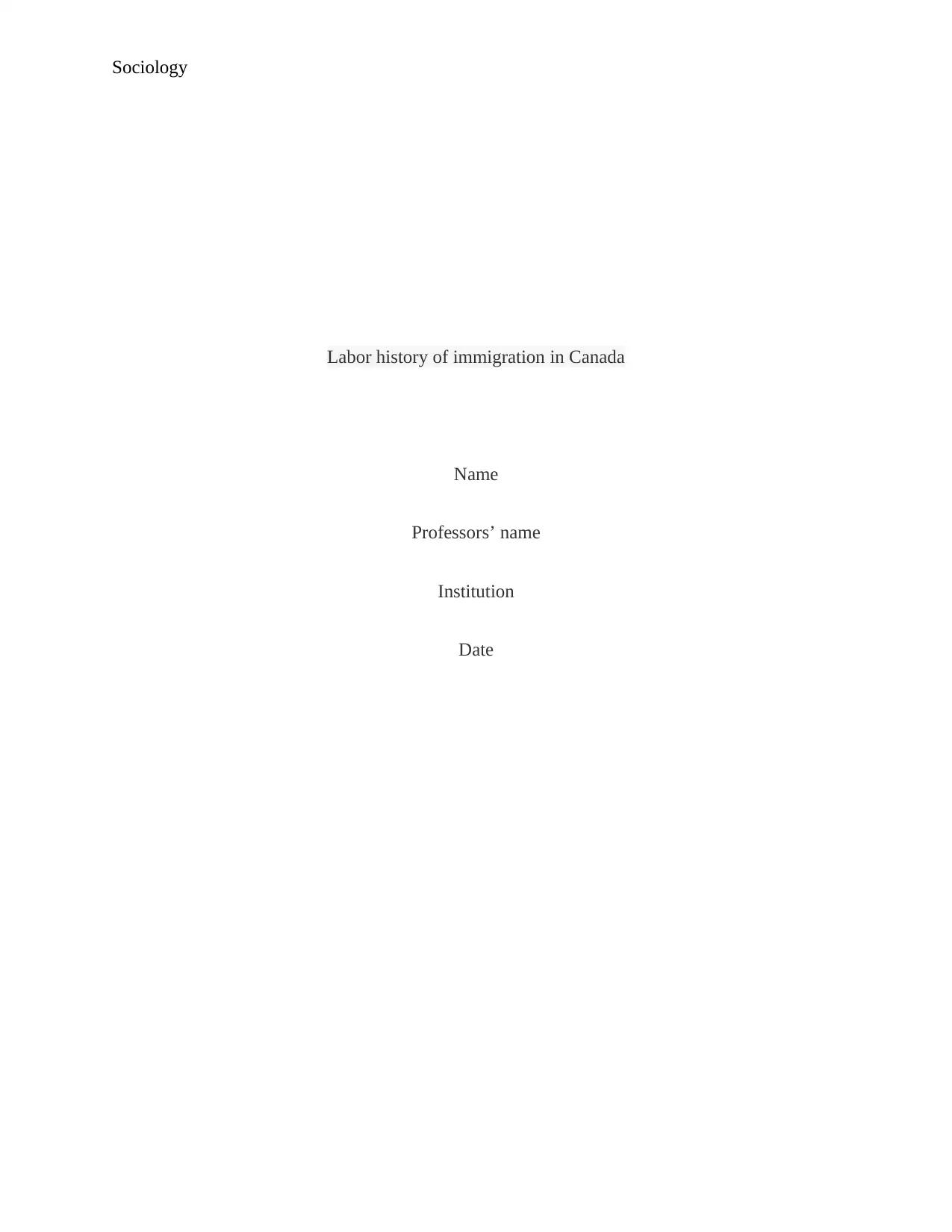
Sociology
Labor history of immigration in Canada
Name
Professors’ name
Institution
Date
Labor history of immigration in Canada
Name
Professors’ name
Institution
Date
Secure Best Marks with AI Grader
Need help grading? Try our AI Grader for instant feedback on your assignments.
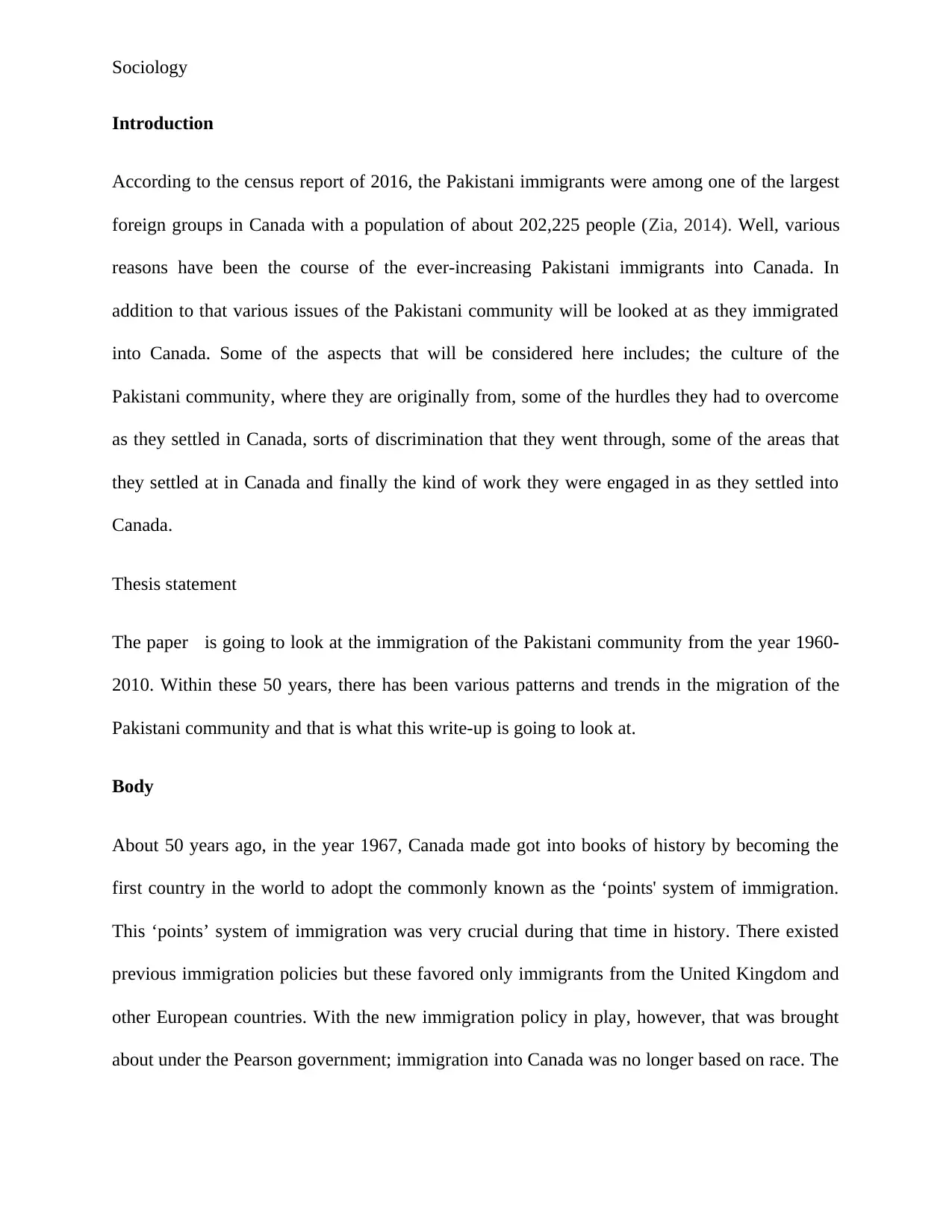
Sociology
Introduction
According to the census report of 2016, the Pakistani immigrants were among one of the largest
foreign groups in Canada with a population of about 202,225 people (Zia, 2014). Well, various
reasons have been the course of the ever-increasing Pakistani immigrants into Canada. In
addition to that various issues of the Pakistani community will be looked at as they immigrated
into Canada. Some of the aspects that will be considered here includes; the culture of the
Pakistani community, where they are originally from, some of the hurdles they had to overcome
as they settled in Canada, sorts of discrimination that they went through, some of the areas that
they settled at in Canada and finally the kind of work they were engaged in as they settled into
Canada.
Thesis statement
The paper is going to look at the immigration of the Pakistani community from the year 1960-
2010. Within these 50 years, there has been various patterns and trends in the migration of the
Pakistani community and that is what this write-up is going to look at.
Body
About 50 years ago, in the year 1967, Canada made got into books of history by becoming the
first country in the world to adopt the commonly known as the ‘points' system of immigration.
This ‘points’ system of immigration was very crucial during that time in history. There existed
previous immigration policies but these favored only immigrants from the United Kingdom and
other European countries. With the new immigration policy in play, however, that was brought
about under the Pearson government; immigration into Canada was no longer based on race. The
Introduction
According to the census report of 2016, the Pakistani immigrants were among one of the largest
foreign groups in Canada with a population of about 202,225 people (Zia, 2014). Well, various
reasons have been the course of the ever-increasing Pakistani immigrants into Canada. In
addition to that various issues of the Pakistani community will be looked at as they immigrated
into Canada. Some of the aspects that will be considered here includes; the culture of the
Pakistani community, where they are originally from, some of the hurdles they had to overcome
as they settled in Canada, sorts of discrimination that they went through, some of the areas that
they settled at in Canada and finally the kind of work they were engaged in as they settled into
Canada.
Thesis statement
The paper is going to look at the immigration of the Pakistani community from the year 1960-
2010. Within these 50 years, there has been various patterns and trends in the migration of the
Pakistani community and that is what this write-up is going to look at.
Body
About 50 years ago, in the year 1967, Canada made got into books of history by becoming the
first country in the world to adopt the commonly known as the ‘points' system of immigration.
This ‘points’ system of immigration was very crucial during that time in history. There existed
previous immigration policies but these favored only immigrants from the United Kingdom and
other European countries. With the new immigration policy in play, however, that was brought
about under the Pearson government; immigration into Canada was no longer based on race. The
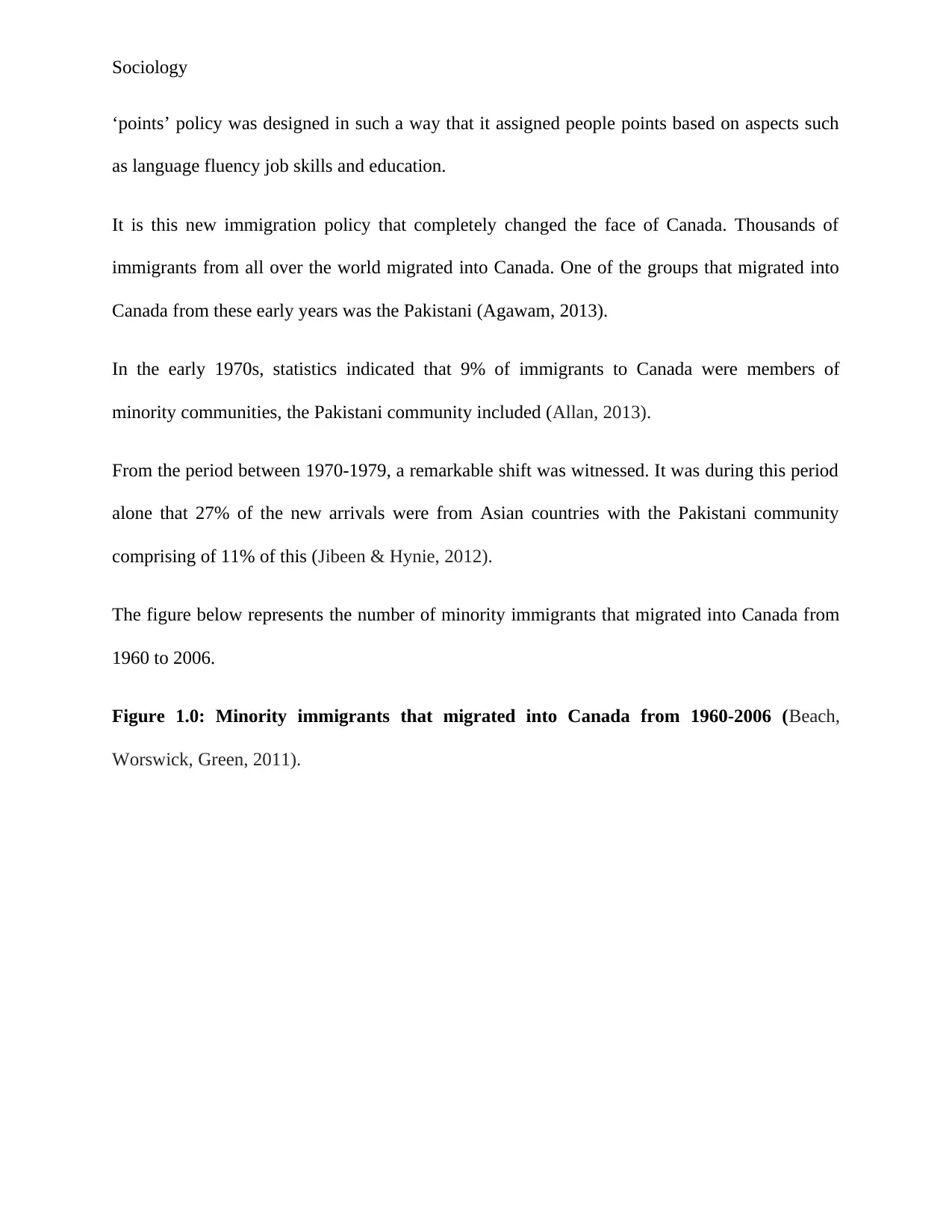
Sociology
‘points’ policy was designed in such a way that it assigned people points based on aspects such
as language fluency job skills and education.
It is this new immigration policy that completely changed the face of Canada. Thousands of
immigrants from all over the world migrated into Canada. One of the groups that migrated into
Canada from these early years was the Pakistani (Agawam, 2013).
In the early 1970s, statistics indicated that 9% of immigrants to Canada were members of
minority communities, the Pakistani community included (Allan, 2013).
From the period between 1970-1979, a remarkable shift was witnessed. It was during this period
alone that 27% of the new arrivals were from Asian countries with the Pakistani community
comprising of 11% of this (Jibeen & Hynie, 2012).
The figure below represents the number of minority immigrants that migrated into Canada from
1960 to 2006.
Figure 1.0: Minority immigrants that migrated into Canada from 1960-2006 (Beach,
Worswick, Green, 2011).
‘points’ policy was designed in such a way that it assigned people points based on aspects such
as language fluency job skills and education.
It is this new immigration policy that completely changed the face of Canada. Thousands of
immigrants from all over the world migrated into Canada. One of the groups that migrated into
Canada from these early years was the Pakistani (Agawam, 2013).
In the early 1970s, statistics indicated that 9% of immigrants to Canada were members of
minority communities, the Pakistani community included (Allan, 2013).
From the period between 1970-1979, a remarkable shift was witnessed. It was during this period
alone that 27% of the new arrivals were from Asian countries with the Pakistani community
comprising of 11% of this (Jibeen & Hynie, 2012).
The figure below represents the number of minority immigrants that migrated into Canada from
1960 to 2006.
Figure 1.0: Minority immigrants that migrated into Canada from 1960-2006 (Beach,
Worswick, Green, 2011).

Sociology
Pakistani immigrants into Canada have been increasing year in year out. Between 1999 and 2001
the Pakistani population in Canada was about 79325.
The Pakistani community came from Pakistan, an Islamic county located in the Middle East.
Despite gaining independence in 1947, Pakistan has had so many domestic wars and many years
of restlessness.
In the early years, the Pakistani community migrated into Canada to look for a better livelihood.
Some of them were escaping from political tension that existed in their country, civil wars and
various forms of persecutions. With the introduction of the ‘points' policy of immigration, the
number of Pakistani immigrates increased.
From the late 1990s to 2010 various reasons for the increased immigration of the Pakistani
population existed. First and foremost, a great population came into Canada from Pakistani in
search of employment opportunities. Canada is ranked among one of the richest countries in the
Pakistani immigrants into Canada have been increasing year in year out. Between 1999 and 2001
the Pakistani population in Canada was about 79325.
The Pakistani community came from Pakistan, an Islamic county located in the Middle East.
Despite gaining independence in 1947, Pakistan has had so many domestic wars and many years
of restlessness.
In the early years, the Pakistani community migrated into Canada to look for a better livelihood.
Some of them were escaping from political tension that existed in their country, civil wars and
various forms of persecutions. With the introduction of the ‘points' policy of immigration, the
number of Pakistani immigrates increased.
From the late 1990s to 2010 various reasons for the increased immigration of the Pakistani
population existed. First and foremost, a great population came into Canada from Pakistani in
search of employment opportunities. Canada is ranked among one of the richest countries in the
Secure Best Marks with AI Grader
Need help grading? Try our AI Grader for instant feedback on your assignments.
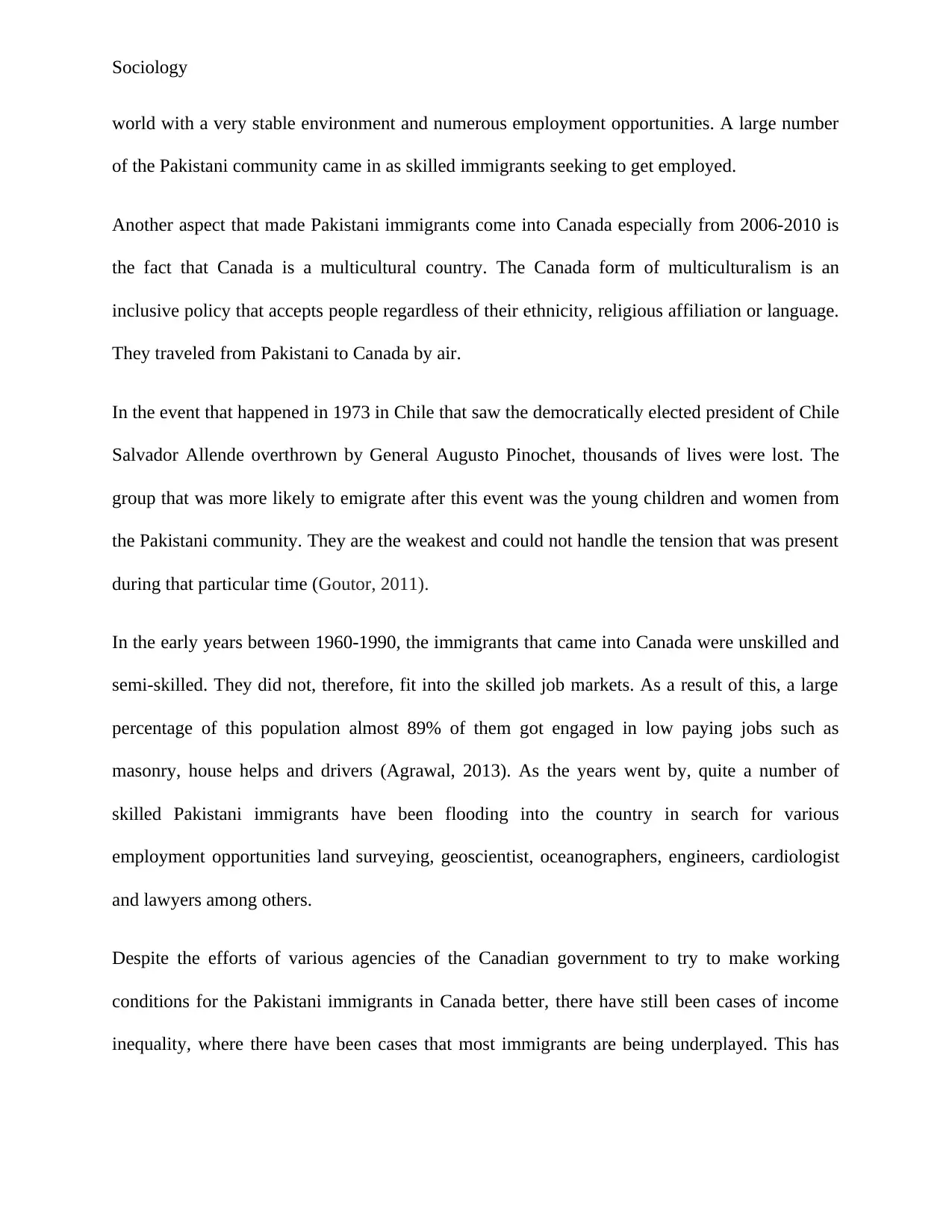
Sociology
world with a very stable environment and numerous employment opportunities. A large number
of the Pakistani community came in as skilled immigrants seeking to get employed.
Another aspect that made Pakistani immigrants come into Canada especially from 2006-2010 is
the fact that Canada is a multicultural country. The Canada form of multiculturalism is an
inclusive policy that accepts people regardless of their ethnicity, religious affiliation or language.
They traveled from Pakistani to Canada by air.
In the event that happened in 1973 in Chile that saw the democratically elected president of Chile
Salvador Allende overthrown by General Augusto Pinochet, thousands of lives were lost. The
group that was more likely to emigrate after this event was the young children and women from
the Pakistani community. They are the weakest and could not handle the tension that was present
during that particular time (Goutor, 2011).
In the early years between 1960-1990, the immigrants that came into Canada were unskilled and
semi-skilled. They did not, therefore, fit into the skilled job markets. As a result of this, a large
percentage of this population almost 89% of them got engaged in low paying jobs such as
masonry, house helps and drivers (Agrawal, 2013). As the years went by, quite a number of
skilled Pakistani immigrants have been flooding into the country in search for various
employment opportunities land surveying, geoscientist, oceanographers, engineers, cardiologist
and lawyers among others.
Despite the efforts of various agencies of the Canadian government to try to make working
conditions for the Pakistani immigrants in Canada better, there have still been cases of income
inequality, where there have been cases that most immigrants are being underplayed. This has
world with a very stable environment and numerous employment opportunities. A large number
of the Pakistani community came in as skilled immigrants seeking to get employed.
Another aspect that made Pakistani immigrants come into Canada especially from 2006-2010 is
the fact that Canada is a multicultural country. The Canada form of multiculturalism is an
inclusive policy that accepts people regardless of their ethnicity, religious affiliation or language.
They traveled from Pakistani to Canada by air.
In the event that happened in 1973 in Chile that saw the democratically elected president of Chile
Salvador Allende overthrown by General Augusto Pinochet, thousands of lives were lost. The
group that was more likely to emigrate after this event was the young children and women from
the Pakistani community. They are the weakest and could not handle the tension that was present
during that particular time (Goutor, 2011).
In the early years between 1960-1990, the immigrants that came into Canada were unskilled and
semi-skilled. They did not, therefore, fit into the skilled job markets. As a result of this, a large
percentage of this population almost 89% of them got engaged in low paying jobs such as
masonry, house helps and drivers (Agrawal, 2013). As the years went by, quite a number of
skilled Pakistani immigrants have been flooding into the country in search for various
employment opportunities land surveying, geoscientist, oceanographers, engineers, cardiologist
and lawyers among others.
Despite the efforts of various agencies of the Canadian government to try to make working
conditions for the Pakistani immigrants in Canada better, there have still been cases of income
inequality, where there have been cases that most immigrants are being underplayed. This has
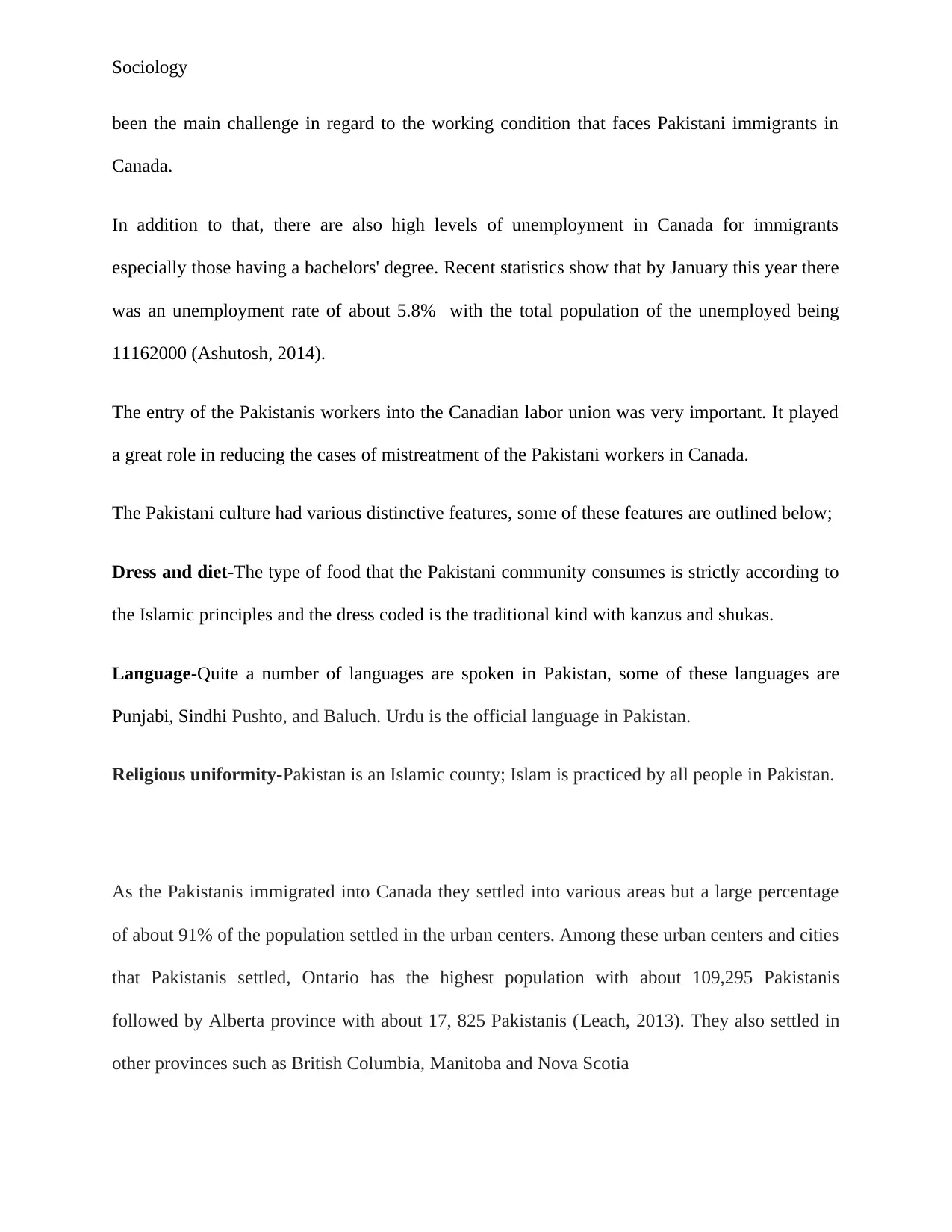
Sociology
been the main challenge in regard to the working condition that faces Pakistani immigrants in
Canada.
In addition to that, there are also high levels of unemployment in Canada for immigrants
especially those having a bachelors' degree. Recent statistics show that by January this year there
was an unemployment rate of about 5.8% with the total population of the unemployed being
11162000 (Ashutosh, 2014).
The entry of the Pakistanis workers into the Canadian labor union was very important. It played
a great role in reducing the cases of mistreatment of the Pakistani workers in Canada.
The Pakistani culture had various distinctive features, some of these features are outlined below;
Dress and diet-The type of food that the Pakistani community consumes is strictly according to
the Islamic principles and the dress coded is the traditional kind with kanzus and shukas.
Language-Quite a number of languages are spoken in Pakistan, some of these languages are
Punjabi, Sindhi Pushto, and Baluch. Urdu is the official language in Pakistan.
Religious uniformity-Pakistan is an Islamic county; Islam is practiced by all people in Pakistan.
As the Pakistanis immigrated into Canada they settled into various areas but a large percentage
of about 91% of the population settled in the urban centers. Among these urban centers and cities
that Pakistanis settled, Ontario has the highest population with about 109,295 Pakistanis
followed by Alberta province with about 17, 825 Pakistanis (Leach, 2013). They also settled in
other provinces such as British Columbia, Manitoba and Nova Scotia
been the main challenge in regard to the working condition that faces Pakistani immigrants in
Canada.
In addition to that, there are also high levels of unemployment in Canada for immigrants
especially those having a bachelors' degree. Recent statistics show that by January this year there
was an unemployment rate of about 5.8% with the total population of the unemployed being
11162000 (Ashutosh, 2014).
The entry of the Pakistanis workers into the Canadian labor union was very important. It played
a great role in reducing the cases of mistreatment of the Pakistani workers in Canada.
The Pakistani culture had various distinctive features, some of these features are outlined below;
Dress and diet-The type of food that the Pakistani community consumes is strictly according to
the Islamic principles and the dress coded is the traditional kind with kanzus and shukas.
Language-Quite a number of languages are spoken in Pakistan, some of these languages are
Punjabi, Sindhi Pushto, and Baluch. Urdu is the official language in Pakistan.
Religious uniformity-Pakistan is an Islamic county; Islam is practiced by all people in Pakistan.
As the Pakistanis immigrated into Canada they settled into various areas but a large percentage
of about 91% of the population settled in the urban centers. Among these urban centers and cities
that Pakistanis settled, Ontario has the highest population with about 109,295 Pakistanis
followed by Alberta province with about 17, 825 Pakistanis (Leach, 2013). They also settled in
other provinces such as British Columbia, Manitoba and Nova Scotia
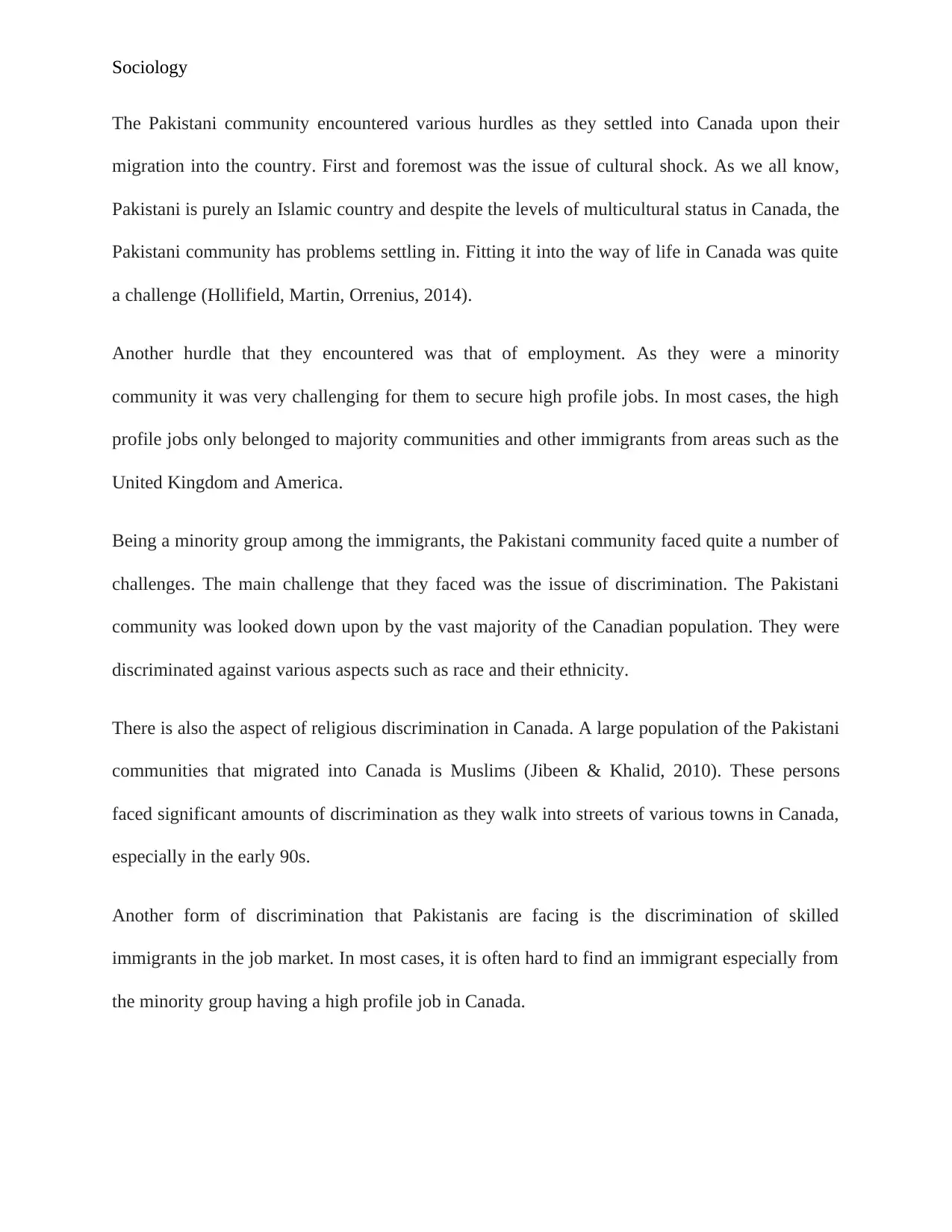
Sociology
The Pakistani community encountered various hurdles as they settled into Canada upon their
migration into the country. First and foremost was the issue of cultural shock. As we all know,
Pakistani is purely an Islamic country and despite the levels of multicultural status in Canada, the
Pakistani community has problems settling in. Fitting it into the way of life in Canada was quite
a challenge (Hollifield, Martin, Orrenius, 2014).
Another hurdle that they encountered was that of employment. As they were a minority
community it was very challenging for them to secure high profile jobs. In most cases, the high
profile jobs only belonged to majority communities and other immigrants from areas such as the
United Kingdom and America.
Being a minority group among the immigrants, the Pakistani community faced quite a number of
challenges. The main challenge that they faced was the issue of discrimination. The Pakistani
community was looked down upon by the vast majority of the Canadian population. They were
discriminated against various aspects such as race and their ethnicity.
There is also the aspect of religious discrimination in Canada. A large population of the Pakistani
communities that migrated into Canada is Muslims (Jibeen & Khalid, 2010). These persons
faced significant amounts of discrimination as they walk into streets of various towns in Canada,
especially in the early 90s.
Another form of discrimination that Pakistanis are facing is the discrimination of skilled
immigrants in the job market. In most cases, it is often hard to find an immigrant especially from
the minority group having a high profile job in Canada.
The Pakistani community encountered various hurdles as they settled into Canada upon their
migration into the country. First and foremost was the issue of cultural shock. As we all know,
Pakistani is purely an Islamic country and despite the levels of multicultural status in Canada, the
Pakistani community has problems settling in. Fitting it into the way of life in Canada was quite
a challenge (Hollifield, Martin, Orrenius, 2014).
Another hurdle that they encountered was that of employment. As they were a minority
community it was very challenging for them to secure high profile jobs. In most cases, the high
profile jobs only belonged to majority communities and other immigrants from areas such as the
United Kingdom and America.
Being a minority group among the immigrants, the Pakistani community faced quite a number of
challenges. The main challenge that they faced was the issue of discrimination. The Pakistani
community was looked down upon by the vast majority of the Canadian population. They were
discriminated against various aspects such as race and their ethnicity.
There is also the aspect of religious discrimination in Canada. A large population of the Pakistani
communities that migrated into Canada is Muslims (Jibeen & Khalid, 2010). These persons
faced significant amounts of discrimination as they walk into streets of various towns in Canada,
especially in the early 90s.
Another form of discrimination that Pakistanis are facing is the discrimination of skilled
immigrants in the job market. In most cases, it is often hard to find an immigrant especially from
the minority group having a high profile job in Canada.
Paraphrase This Document
Need a fresh take? Get an instant paraphrase of this document with our AI Paraphraser

Sociology
It is important to however note that this discrimination was dominant in the early 1980s to early
2000. In recent years the levels of discrimination have really gown down as a result of the
multicultural nature of the country (Fortin, Lemieux, Torres, 2016).
These rampant cases of discrimination have been common in Canada. Minority immigrants
including the Pakistanis dealt with this issue by coming out and speaking for their rights, this is
through the use of various immigrants’ lawyers, advocates, and other legal representatives.
Conclusion
Pakistan immigrants faced quite a number of challenges as it settled into Canada such as
discrimination and aspects of cultural shock (Strauss & McGrath, 2017). The Pakistani
immigration was gradual and it began immediately after the introduction of the ‘point’ policy in
1973. Pakistani settled into various parts of Canada securing the vast employment opportunities
in the country. Till date, Pakistanis are still migrating into Canada.
\
It is important to however note that this discrimination was dominant in the early 1980s to early
2000. In recent years the levels of discrimination have really gown down as a result of the
multicultural nature of the country (Fortin, Lemieux, Torres, 2016).
These rampant cases of discrimination have been common in Canada. Minority immigrants
including the Pakistanis dealt with this issue by coming out and speaking for their rights, this is
through the use of various immigrants’ lawyers, advocates, and other legal representatives.
Conclusion
Pakistan immigrants faced quite a number of challenges as it settled into Canada such as
discrimination and aspects of cultural shock (Strauss & McGrath, 2017). The Pakistani
immigration was gradual and it began immediately after the introduction of the ‘point’ policy in
1973. Pakistani settled into various parts of Canada securing the vast employment opportunities
in the country. Till date, Pakistanis are still migrating into Canada.
\
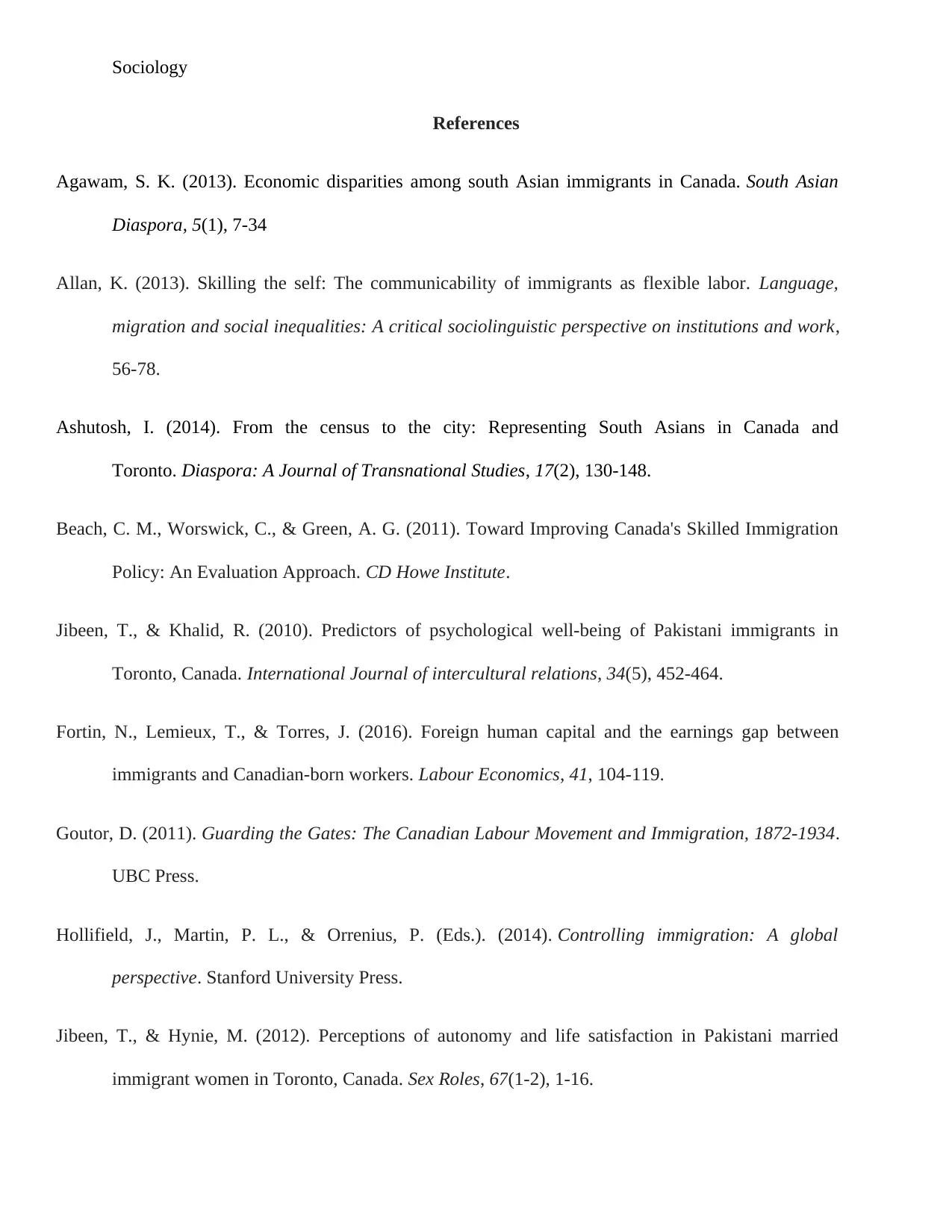
Sociology
References
Agawam, S. K. (2013). Economic disparities among south Asian immigrants in Canada. South Asian
Diaspora, 5(1), 7-34
Allan, K. (2013). Skilling the self: The communicability of immigrants as flexible labor. Language,
migration and social inequalities: A critical sociolinguistic perspective on institutions and work,
56-78.
Ashutosh, I. (2014). From the census to the city: Representing South Asians in Canada and
Toronto. Diaspora: A Journal of Transnational Studies, 17(2), 130-148.
Beach, C. M., Worswick, C., & Green, A. G. (2011). Toward Improving Canada's Skilled Immigration
Policy: An Evaluation Approach. CD Howe Institute.
Jibeen, T., & Khalid, R. (2010). Predictors of psychological well-being of Pakistani immigrants in
Toronto, Canada. International Journal of intercultural relations, 34(5), 452-464.
Fortin, N., Lemieux, T., & Torres, J. (2016). Foreign human capital and the earnings gap between
immigrants and Canadian-born workers. Labour Economics, 41, 104-119.
Goutor, D. (2011). Guarding the Gates: The Canadian Labour Movement and Immigration, 1872-1934.
UBC Press.
Hollifield, J., Martin, P. L., & Orrenius, P. (Eds.). (2014). Controlling immigration: A global
perspective. Stanford University Press.
Jibeen, T., & Hynie, M. (2012). Perceptions of autonomy and life satisfaction in Pakistani married
immigrant women in Toronto, Canada. Sex Roles, 67(1-2), 1-16.
References
Agawam, S. K. (2013). Economic disparities among south Asian immigrants in Canada. South Asian
Diaspora, 5(1), 7-34
Allan, K. (2013). Skilling the self: The communicability of immigrants as flexible labor. Language,
migration and social inequalities: A critical sociolinguistic perspective on institutions and work,
56-78.
Ashutosh, I. (2014). From the census to the city: Representing South Asians in Canada and
Toronto. Diaspora: A Journal of Transnational Studies, 17(2), 130-148.
Beach, C. M., Worswick, C., & Green, A. G. (2011). Toward Improving Canada's Skilled Immigration
Policy: An Evaluation Approach. CD Howe Institute.
Jibeen, T., & Khalid, R. (2010). Predictors of psychological well-being of Pakistani immigrants in
Toronto, Canada. International Journal of intercultural relations, 34(5), 452-464.
Fortin, N., Lemieux, T., & Torres, J. (2016). Foreign human capital and the earnings gap between
immigrants and Canadian-born workers. Labour Economics, 41, 104-119.
Goutor, D. (2011). Guarding the Gates: The Canadian Labour Movement and Immigration, 1872-1934.
UBC Press.
Hollifield, J., Martin, P. L., & Orrenius, P. (Eds.). (2014). Controlling immigration: A global
perspective. Stanford University Press.
Jibeen, T., & Hynie, M. (2012). Perceptions of autonomy and life satisfaction in Pakistani married
immigrant women in Toronto, Canada. Sex Roles, 67(1-2), 1-16.
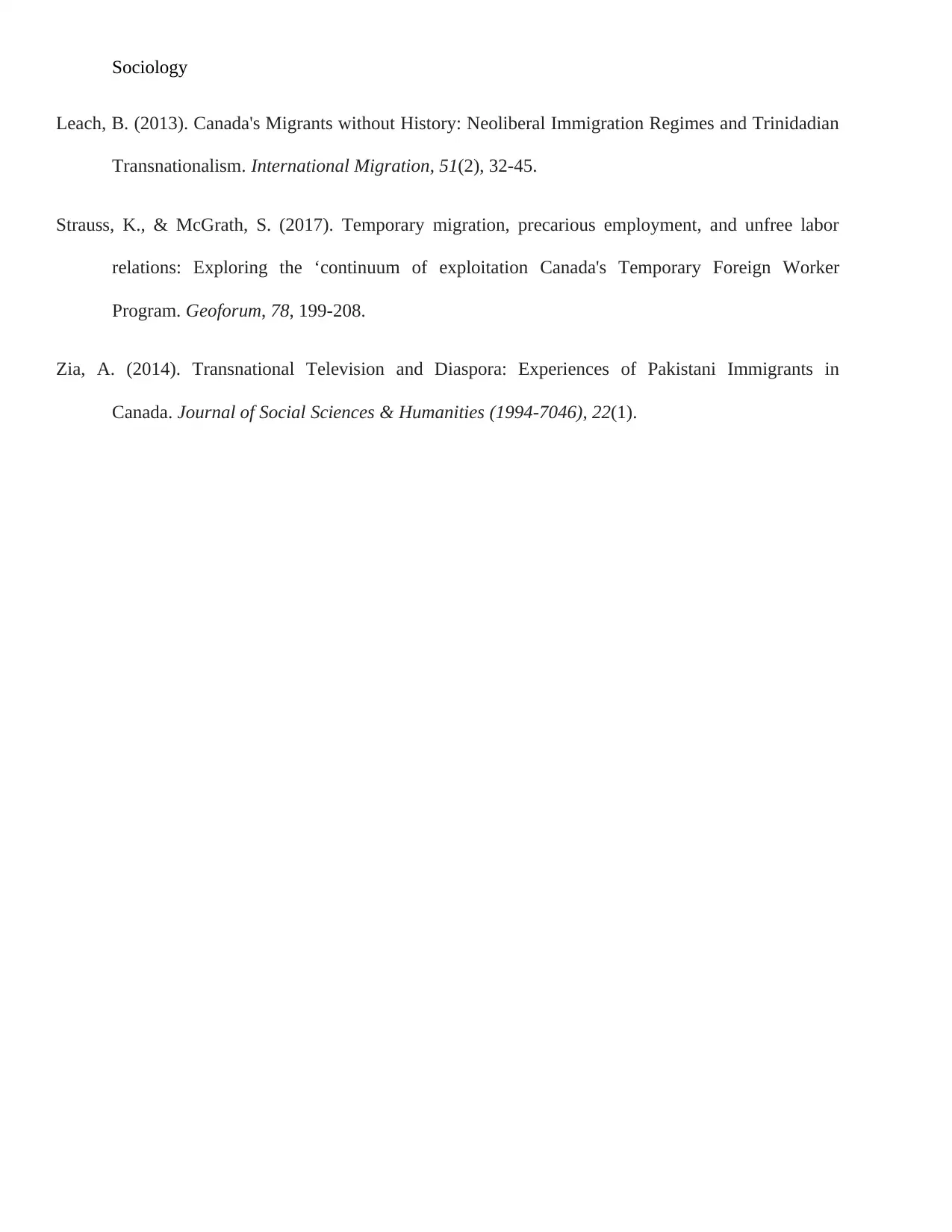
Sociology
Leach, B. (2013). Canada's Migrants without History: Neoliberal Immigration Regimes and Trinidadian
Transnationalism. International Migration, 51(2), 32-45.
Strauss, K., & McGrath, S. (2017). Temporary migration, precarious employment, and unfree labor
relations: Exploring the ‘continuum of exploitation Canada's Temporary Foreign Worker
Program. Geoforum, 78, 199-208.
Zia, A. (2014). Transnational Television and Diaspora: Experiences of Pakistani Immigrants in
Canada. Journal of Social Sciences & Humanities (1994-7046), 22(1).
Leach, B. (2013). Canada's Migrants without History: Neoliberal Immigration Regimes and Trinidadian
Transnationalism. International Migration, 51(2), 32-45.
Strauss, K., & McGrath, S. (2017). Temporary migration, precarious employment, and unfree labor
relations: Exploring the ‘continuum of exploitation Canada's Temporary Foreign Worker
Program. Geoforum, 78, 199-208.
Zia, A. (2014). Transnational Television and Diaspora: Experiences of Pakistani Immigrants in
Canada. Journal of Social Sciences & Humanities (1994-7046), 22(1).
1 out of 10
Related Documents
Your All-in-One AI-Powered Toolkit for Academic Success.
+13062052269
info@desklib.com
Available 24*7 on WhatsApp / Email
![[object Object]](/_next/static/media/star-bottom.7253800d.svg)
Unlock your academic potential
© 2024 | Zucol Services PVT LTD | All rights reserved.





